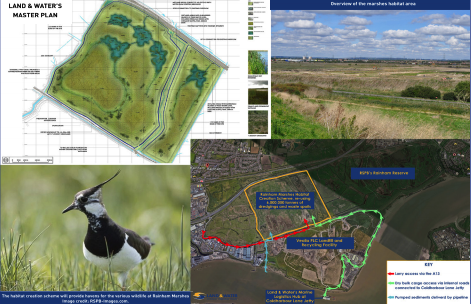| Date | November 1st 2018 |
"This is hugely welcome news, enabling us to achieve our ambitions for the silt lagoons. The dredgings will enable the lagoons to be improved, creating new places for wildlife - pools linked by ditches for wading birds and wetland species, and drier grassy areas for important insects such as bumblebees. We’re confident that our partnership with Land & Water and the Port of London Authority will provide an environment for generations of visitors to enjoy." Andrew Gouldstone, RSPB Site Manager at Rainham Marshes nature reserve
WHAT WAS NEEDED?
Land & Water gained consent for developing a Habitat Creation Scheme on the River Thames at Rainham Marshes, the largest habitat creation project ever constructed inside the M25. The project will involve creating a significant area of new wetland habitat from re-engineered spoils, coupled with a strategic investment in riverside infrastructure to support along the Thames Corridor for decades to come.
LAND & WATER’S SOLUTION
The scheme will see the importation of over six million tonnes of wet and dry spoil material which will form both the basis of a new landform and cover the site to collect rainwater to fuel the wetlands passively. The site sits between Veolia’s landfill site at Rainham and the RSPB’s Rainham reserve. With the new area creating 1,000,000m2 of habitat, more than 5km2 of continuous habitats will be formed, providing East London with an oasis of wildlife owned and managed by the RSPB. This is Land & Water’s most ambitious project to date. A detailed operations plan has been developed with the RSPB so that areas of the site are operated between migratory bird nesting seasons, with compensation habitats pre-constructed to provide essential refuges. Wet and dry spoils are delivered to the site throughout the year, and “air dried” (when required) in purpose built drying lagoons. Within the lowecological impact periods, the spoils are re-handled to their final resting place with the dredged materials placed to form the landform. A cohesive layer and restoration soils are then over-lain to act as the gigantic rainwater harvesting blanket that will permanently feed the low-land wetlands. The final landform consists of a patchwork of habitats. These include upland/ dry/sandy areas ideal for some ground nesting species, with shallow valleys and damp swales, and collecting ditches that eventually channel surface waters to the permanent wetlands.
“Our involvement at Rainham can be cast back more than five years, to a time when we undertook an options appraisal on behalf of the Port of London Authority. We analysed ways in which the former dredging disposal lagoons alongside the A13 at Rainham Marshes, could be reinvigorated to support infrastructure projects along the Thames.” James Maclean, Chief Executive at Land & Water and mastermind of the scheme
Land & Water has ensured easy access to the site from both the river and the A13 main trunk road which means that material can now be transported by both marine craft and lorry. Rainham Silt Lagoons is on the north bank of the River Thames at Coldharbour Lane, Rainham, RM13 9YQ. Contact Land & Water on 0844 2251958 or the site manager directly on 07967 461 025.
THE RESULTS
- 3.5 million cubic meters of void immediately available for non-hazardous dredgings and restoration soils
- Habitat creation scheme
- Direct river access
- Consented environmental permit
"We are pleased to be partnering with Land & Water to reactivate the silt lagoons at Rainham. The site will be filled with material dredged from the Thames and restored to create valuable new habitat appropriate for sustaining its status as a Site of Special Scientific Interest for wetland birds and wildlife. By increasing use of barges for freight transport, and creating new habitat, the development contributes directly towards delivering the Thames Vision, our plan to maximise the social, environmental and economic well-being of the river over the next 30 years" Tanya Ferry, Environment Manager at the Port of London Authority (PLA)

